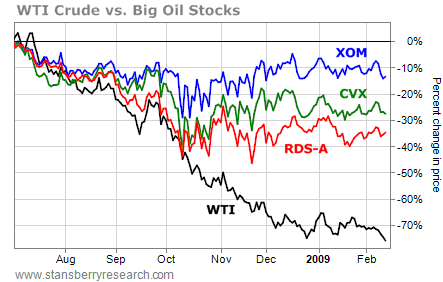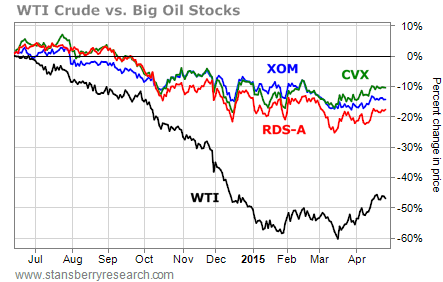If you want to invest in the oil sector, conventional wisdom says Big Oil stocks like ExxonMobil, Chevron, and Royal Dutch Shell are the best way to do it.
Major oil companies are considered some of the safest oil stocks to own.
[ad#Google Adsense 336×280-IA]They pay regular dividends.
These companies also operate all over the world and have diversified revenue streams.
Because of this, they often insulate you from volatile moves in the price of oil.
That’s what we saw the last time the oil price took a beating.
And it’s what we’ve seen so far over the past few months. But it doesn’t mean it’s what we’ll see going forward…
The last time the oil price collapsed was from 2008 to 2009. From its 2008 peak to its 2009 low, the price of benchmark West Texas Intermediate (WTI) crude oil fell 77%. But Big Oil stocks like ExxonMobil (XOM), Chevron (CVX), and Royal Dutch Shell (RDS-A) only fell around 13%, 27%, and 34%, respectively, during that time frame.

There were two main reasons these stocks fell less than the oil price.
For one, ExxonMobil, Chevron, and Royal Dutch Shell had dealt with oil-price declines before. As regular Growth Stock Wire readers know, oil is tremendously cyclical. That means its price moves in waves. It goes through cycles of boom and bust.
That’s why these companies have strategies in place to survive – including owning low-cost, long-life exploration and production (E&P) assets.
So while their assets became less valuable when the price of oil dropped, profit margins remained positive.
For example, in 2008, ExxonMobil’s net income from its E&P assets was $35.4 billion. That number fell more than in half – to $17.1 billion – in 2009. It was a big drop, but it was sufficient to support the rest of the company.
Meanwhile, Royal Dutch Shell’s net income from its E&P assets fell from $21.7 billion in 2008 to $10.4 billion in 2010. And Chevron’s fell from $25.6 billion in 2008 to $8.4 billion in 2009. These were also big drops, but their income was still enough to support the companies.
The second reason Big Oil stocks fell less than oil prices was because the market anticipated the oil-price drop was a temporary event. So even though oil prices were falling, investors remained optimistic that oil prices would bounce back. This helped support shares of Big Oil producers.
Investors were right to be bullish… to help oil prices recover, Saudi Arabia, the leader of the Organization of the Petroleum Exporting Countries (OPEC), cut its oil production. Saudi Arabia’s cuts (with help from the United Arab Emirates, Kuwait, and Libya) made sure the world’s oil supply fell by enough to send oil prices soaring.
In total, the WTI crude price soared 214% from its March 2009 bottom to its June 2014 top. ExxonMobil, Chevron, and Royal Dutch Shell shares rose 54%, 116%, and 110%, respectively, during the same time frame. So investors who bought these stocks in 2008 and 2009 were shielded from most of the sector’s weakness… and they profited from the rebound.
We’re seeing a similar situation in the oil sector today. The WTI crude oil price has fallen around 46% from its June 2014 high. But ExxonMobil, Chevron, and Royal Dutch Shell are down around just 14%, 12%, and 17%, respectively, over the same period. That’s an average 32% difference between the changes in the price of oil and the price of these stocks.

Just like in 2009, these companies’ strategies have helped insulate them from oil’s price collapse… and with the price of WTI crude up nearly 35% from its March low, the market is anticipating a rebound in oil prices.
But there are a couple major difference between today and 2009…
For starters, these stocks aren’t as cheap today as they were in 2009. You can see this by looking at the ratio of these companies’ enterprise values (market cap plus debt minus cash) and EBITDA (earnings before interest, taxes, depreciation, and amortization). The lower the ratio, the better. As you can see, the valuations of these stocks were much cheaper when the oil price bottomed in 2009:

Also, the market is likely going to be wrong about oil prices rebounding this time. Instead of cutting back production when oil prices fell, Saudi Arabia and the rest of OPEC have kept right on pumping. And there isn’t any planned reduction in the near future.
The U.S. Energy Information Administration (EIA) says worldwide crude oil production is expected to exceed demand by 900,000 barrels of oil per day during the first half of this year.
As long as supply outpaces demand, oil prices aren’t going to significantly rebound… that means low prices will continue to affect the earnings of ExxonMobil, Chevron, and Royal Dutch Shell. That – coupled with the market realizing oil prices aren’t going up – will likely drive investors out of these companies… causing shares to fall closer in line with oil prices.
In short, while Big Oil stocks might seem like a safe bet right now – and their dividends don’t appear to be at risk – don’t expect much price appreciation from them right now.
Good investing,
Brian Weepie
[ad#stansberry-ps]
Source: Growth Stock Wire


